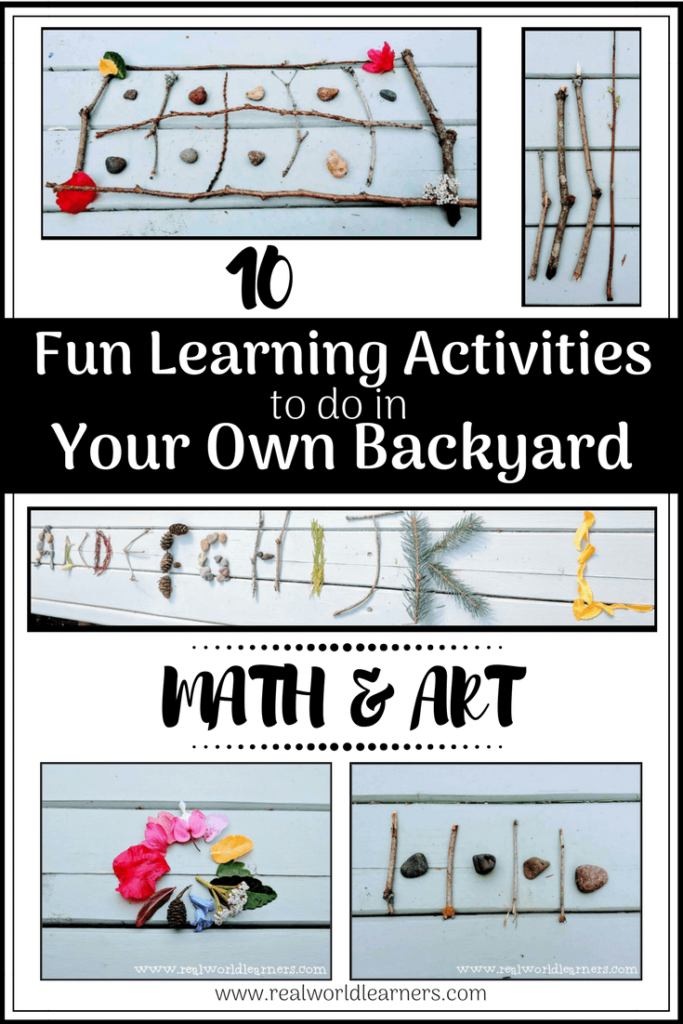 Outside Fun Learning Activities for Kids
Outside Fun Learning Activities for Kids
“Play is our brain’s favorite way of learning.” – Jean Ackerman
This post contains affiliate links.
Free Play
Kids love fun outside activities; when you can easily weave in learning opportunities to their natural play – all the better!
This is not to discount the unequivocal advantage of free play, however. Children need plenty of unstructured free play to develop creativity, problem-solving skills, and conflict resolution skills. This type of unscheduled time to play also gives kids the opportunity to learn for themselves how to break through the “glass ceiling” of boredom and enter the worlds of imagination, fun, and learning that lie beyond that dreaded “b” word.
There are still times, however, for introducing short activities that provide a structured learning environment for kids. Below are some simple ideas for turning outdoor time into learning time, helping kids happily create and learn while playing in nature.
Here’s 10 ideas to help get your kids excited about doing Math and Art (and a bit of Reading and Writing!) next time they head out to the backyard – or park, or beach, or forest … 🙂
1. Ten Frames
Take math outdoors! You can do everything you would normally do with ten frames using sticks and stones :).
You can grab a free ten frame game activity from my store and send the kids on a stick hunt to create their own ten frame. You can replace worksheets with nature, fresh air, and fun conversations!
Read more here about the benefits and uses of ten frames for developing a solid basis in mathematical understanding. You can also download a free chapter from my ebook on teaching math using ten frames to get started on some activities and math journaling with your kids.
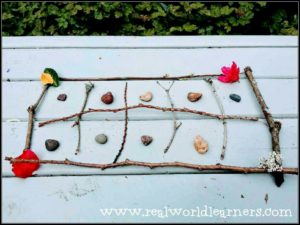
2. Color Wheel
Go on a nature walk around your backyard, park, or neighborhood and pick a petal from as many different colored flowers (including leaves) that you can find. (Make sure you have permission before you pick flowers from private property!)
Lay out your colors in rainbow order (Red, Orange, Yellow, Green, Blue, Indigo, Violet), creating a full color wheel, if possible.
This would be a great activity to do during multiple seasons. Gather a collection of colored leaves in the Fall or brightly colored flowers in the Spring. Take pictures and compare the brilliant colors that Nature offers.
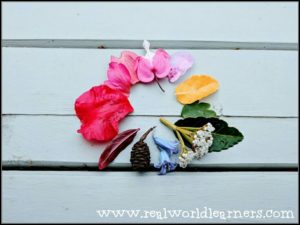
3. Writing
Spell letters or make words with sticks, leaves, flowers, rocks, etc:
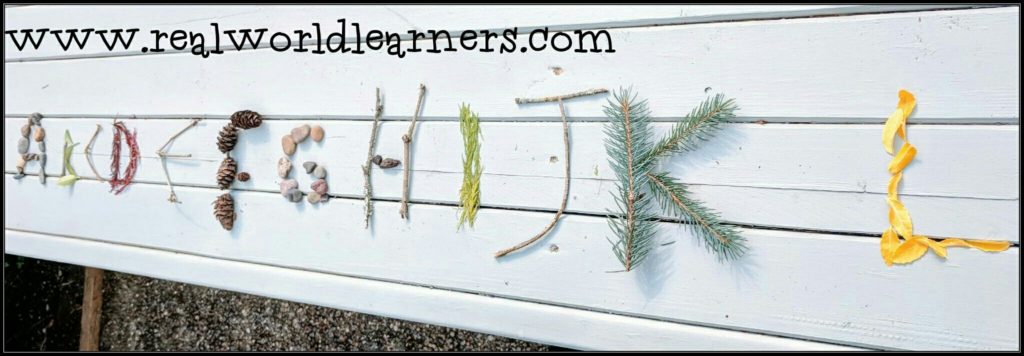
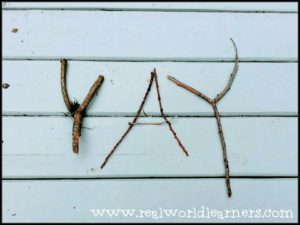
4. Chalk Art
This is the only one on the list that requires pre-bought material – but you can pick up a box of chalk at a dollar store or Walmart, etc.
Here’s some ideas to get your creative juices flowing:
- Trace your hand – or do a whole body outline.
- Draw seasonal decorations – easter eggs, pumpkins, etc.
- Use cookie cutters to trace shapes.
- Write your name in bubble letters.
- Write a short “story” using only hand-drawn emojis.
You could take a lot of “schooling” outdoors with some chalk and pavement too:
- Solve math problems.
- Create flow charts of ideas for a new story or research project.
- Draw diagrams of cell structures or the life cycle of a frog.
- Create a history timeline based on events you are studying.
5. Ordering from least to greatest
Send kids on a treasure hunt looking for sticks, then ask them to try to lay them out in order from least to greatest.
With younger kids, you can introduce comparison words, such as “tall, taller, tallest” or “short, shorter, shortest.” You can also teach them synonyms for “small, medium, and large,” such as “tiny, average, and humongous.”
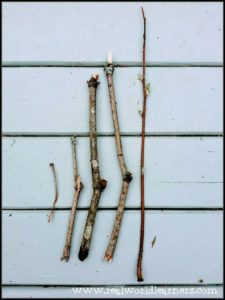
6. Water Painting
Find a stick, a puddle, and a rock/concrete. Dip your stick in water and paint on the rock! 🙂 Read more here about my epic learning moment regarding the simple joys of childhood.
7. Making patterns
Use some of the items you gathered from the scavenger hunt, or collect new sticks, rocks, pine cones, leaves, etc. Try creating repeating patterns, seeing if your kids can correctly place the next item.
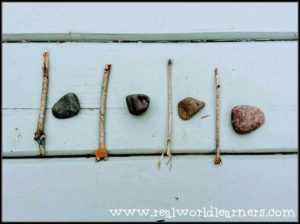
If the simple “a-b” pattern isn’t enough, mix it up and make it more complicated. Try starting a pattern and letting your kids finish it, or have them start patterns for you or each other.
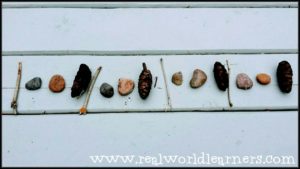
8. Mandalas
Gather a variety of nature treasures (such as rocks, sticks, leaves, flowers, pinecones, bark fragments, etc.). Place one treasure down to be the centerpiece, then place a different set of objects around it in a circle. Continue making circles around the centerpiece, using different types of nature treasures for each layer.
This can be a fun introduction to Geometry, as kids create and discover symmetrical patterns.
9. Fairy houses
This is an open invitation for endless creativity! Start by showing your kids how to construct a really simple “house” out of any materials available in your backyard (or at the park, or the beach, or the forest … ) then encourage them to create their own masterpieces. You can do a quick Google image search to get them started with some ideas, or just let them make whatever they like. Younger kids can make “fairy gardens” by planting sticks and rocks in the ground. There’s no end to what you can do with this, but here’s some starter ideas:
- Use pieces of bark as walls to construct a tiny shelter.
- Gather a lot of sticks and twigs, then layer them up (Lincoln-log style) to make walls of a log cabin.
- Keep it simple by using your finger (or a stick) to trace out a house outline in the dirt, then filling in windows and doors using other items.
- Set up stakes in the ground to form a tent or tee-pee, then drape seaweed or moss or large ferns around it.
10. Create a nature weaving
We haven’t done this one yet, so I don’t have pictures to show, but I’ve seen a lot of these around the internet. You can make a simple frame out of sticks, fill it in with rows of string/yarn, then weave in pretty much anything you can find outside. I’ve seen people make a large one of these and set it up as an ongoing project – the results are beautiful!
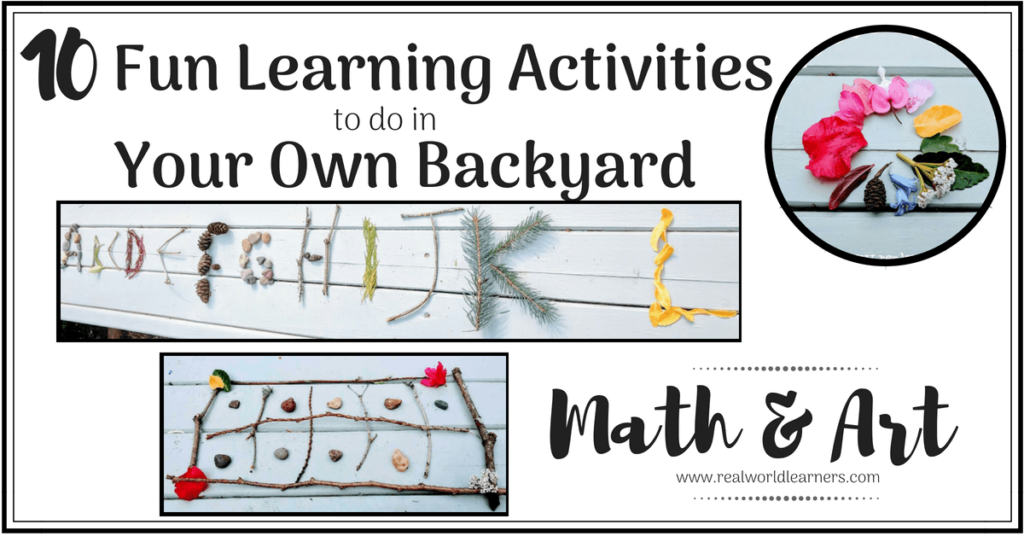
I’d love to hear about any outside fun learning activities you’ve come up with. If you liked these or have any other ideas to add, leave a comment below!
You may also like:
If you’re looking for a complete math curriculum built on a foundation of hands-on, interactive math activities, you will love RightStart Math!


6 comments on “Outside fun learning activities: Math and Art”